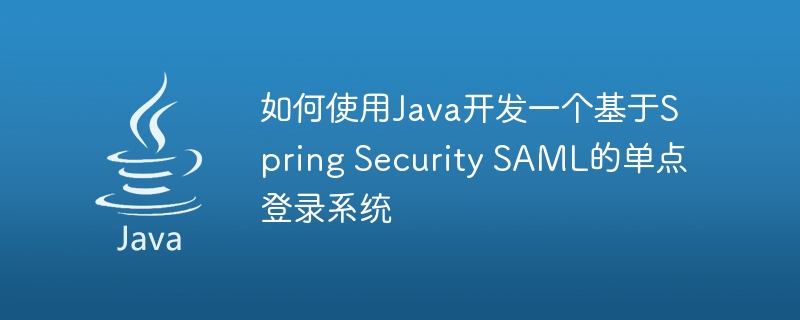如何使用Java開發一個基於Spring Security SAML的單一登入系統

如何使用Java開發一個基於Spring Security SAML的單一登入系統
引言:
隨著網路的快速發展,越來越多的應用程式被開發出來。在這些應用程式中,使用者登入是最常見的功能之一。然而,對於企業級應用程序,用戶需要在多個系統中進行登錄,這將導致用戶的登入體驗非常糟糕。為了解決這個問題,單一登入系統(Single Sign-On,簡稱SSO)應運而生。
簡介:
單一登入系統允許使用者在一次登入後,可以存取企業內部不同系統的應用,而無需重複輸入登入憑證。 Spring Security是一個功能強大的安全框架,而SAML(Security Assertion Markup Language)是一種用於跨域認證和授權的開放式標準。
本文將介紹如何使用Java開發一個基於Spring Security SAML的單一登入系統,並提供特定的程式碼範例。
步驟一:準備工作
- 安裝Java、Spring Boot和Maven。
- 建立一個Spring Boot項目,並且新增依賴:spring-boot-starter-security、spring-security-saml2-core和spring-security-saml2-service-provider。
步驟二:設定SAML
- 在application.properties檔案中設定SP元資料、IDP元資料和金鑰資訊。
# SP元数据 security.saml2.metadata.sp.entity-id= security.saml2.metadata.sp.private-key-location= security.saml2.metadata.sp.public-key-location= # IDP元数据 security.saml2.metadata.idp.entity-id= security.saml2.metadata.idp.single-sign-on-service.location= security.saml2.metadata.idp.single-logout-service.location= # 密钥信息 security.saml2.keystore.location= security.saml2.keystore.password= security.saml2.private-key.password=
- 建立名為"SAMLWebSecurityConfig"的Java類,繼承"SAMLConfigurerAdapter"並覆寫對應的方法。
@Configuration
@EnableWebSecurity
public class SAMLWebSecurityConfig extends SAMLConfigurerAdapter {
@Autowired
private SAMLUserDetailsService samlUserDetailsService;
@Override
protected void configure(HttpSecurity http) throws Exception {
http.authorizeRequests()
.antMatchers("/saml/**").permitAll()
.anyRequest().authenticated()
.and()
.apply(saml())
.userDetailsService(samlUserDetailsService);
}
@Override
protected void configure(AuthenticationManagerBuilder auth) throws Exception {
auth.authenticationProvider(samlAuthenticationProvider());
}
@Bean
public SAMLConfigurer saml() {
return new SAMLConfigurer();
}
@Bean
public SAMLAuthenticationProvider samlAuthenticationProvider() {
return new SAMLAuthenticationProvider();
}
}- 建立名為"SAMLConfigurer"的Java類,繼承"SAMLConfigurerAdapter"並覆寫對應的方法。
public class SAMLConfigurer extends SAMLConfigurerAdapter {
@Override
public void configure(SAMLServiceProviderConfigurer saml) throws Exception {
saml.keyStore()
.storeFilePath(keystoreLocation)
.password(keystorePassword)
.keyname(keyAlias)
.keyPassword(keyPassword)
.and()
.protocol(PROTOCOL)
.hostname(HOSTNAME)
.basePath(BASE_PATH)
.entityId(SP_ENTITY_ID)
.metadataFilePath(SP_METADATA_LOCATION);
}
}步驟三:建立使用者服務
- 建立一個名為"SAMLUser"的Java類,實作"SAMLUserDetailsService"介面並實作對應的方法。
@Service
public class SAMLUser implements SAMLUserDetailsService {
@Override
public Object loadUserBySAML(SAMLCredential credential) throws UsernameNotFoundException {
String username = credential.getNameID().getValue();
// 根据用户名查询用户信息
// ...
// 返回用户详细信息
return new User(username, "", new ArrayList<>());
}
}步驟四:建立控制器
- 建立一個名為"HomeController"的Java類,用於處理登入成功後的跳躍。
@Controller
public class HomeController {
@RequestMapping("/")
public String home() {
return "home";
}
}- 建立一個名為"LogoutController"的Java類,用於處理登出。
@Controller
public class LogoutController {
@RequestMapping("/logout")
public String logout() {
return "logout";
}
}步驟五:建立檢視
- 在src/main/resources/templates目錄下建立home.html和logout.html兩個範本檔案。
home.html:
<!DOCTYPE html>
<html>
<head>
<meta charset="UTF-8">
<title>Home</title>
</head>
<body>
<h1>Welcome to Home Page</h1>
</body>
</html>logout.html:
<!DOCTYPE html>
<html>
<head>
<meta charset="UTF-8">
<title>Logout</title>
</head>
<body>
<h1>You have been logged out</h1>
</body>
</html>總結:
至此,我們已經完成了使用Java開發一個基於Spring Security SAML的單一登入系統的步驟。透過設定SAML和建立使用者服務,我們能夠實現一個穩定安全的登入系統,提供了良好的使用者體驗。
參考資料:
- Spring Security SAML官方文件:https://docs.spring.io/spring-security-saml/docs/current/reference/htmlsingle/
以上是如何使用Java開發一個基於Spring Security SAML的單一登入系統的詳細內容。更多資訊請關注PHP中文網其他相關文章!

熱AI工具

Undresser.AI Undress
人工智慧驅動的應用程序,用於創建逼真的裸體照片

AI Clothes Remover
用於從照片中去除衣服的線上人工智慧工具。

Undress AI Tool
免費脫衣圖片

Clothoff.io
AI脫衣器

AI Hentai Generator
免費產生 AI 無盡。

熱門文章

熱工具

記事本++7.3.1
好用且免費的程式碼編輯器

SublimeText3漢化版
中文版,非常好用

禪工作室 13.0.1
強大的PHP整合開發環境

Dreamweaver CS6
視覺化網頁開發工具

SublimeText3 Mac版
神級程式碼編輯軟體(SublimeText3)

熱門話題
 突破或從Java 8流返回?
Feb 07, 2025 pm 12:09 PM
突破或從Java 8流返回?
Feb 07, 2025 pm 12:09 PM
Java 8引入了Stream API,提供了一種強大且表達力豐富的處理數據集合的方式。然而,使用Stream時,一個常見問題是:如何從forEach操作中中斷或返回? 傳統循環允許提前中斷或返回,但Stream的forEach方法並不直接支持這種方式。本文將解釋原因,並探討在Stream處理系統中實現提前終止的替代方法。 延伸閱讀: Java Stream API改進 理解Stream forEach forEach方法是一個終端操作,它對Stream中的每個元素執行一個操作。它的設計意圖是處
 創造未來:零基礎的 Java 編程
Oct 13, 2024 pm 01:32 PM
創造未來:零基礎的 Java 編程
Oct 13, 2024 pm 01:32 PM
Java是熱門程式語言,適合初學者和經驗豐富的開發者學習。本教學從基礎概念出發,逐步深入解說進階主題。安裝Java開發工具包後,可透過建立簡單的「Hello,World!」程式來實踐程式設計。理解程式碼後,使用命令提示字元編譯並執行程序,控制台上將輸出「Hello,World!」。學習Java開啟了程式設計之旅,隨著掌握程度加深,可創建更複雜的應用程式。












